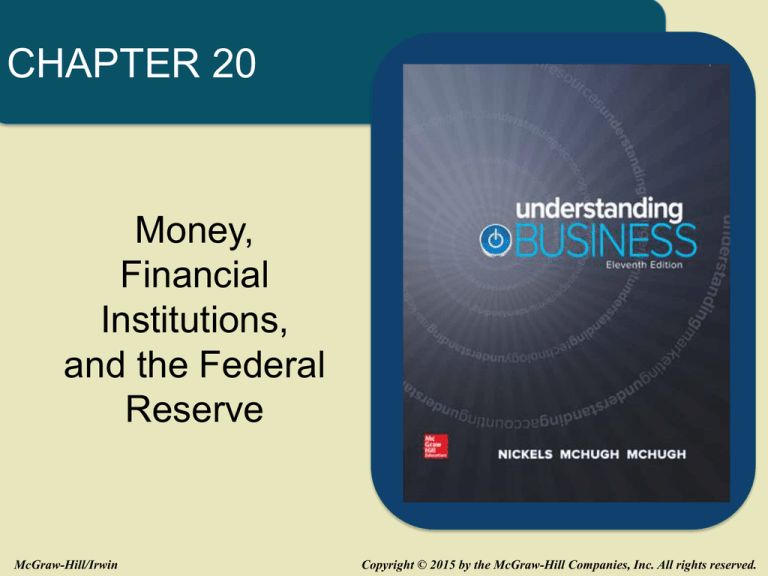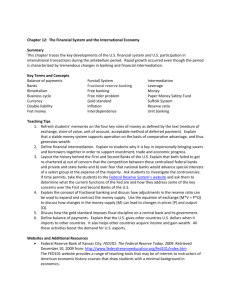
CHAPTER 20
Money,
Financial
Institutions,
and the Federal
Reserve
McGraw-Hill/Irwin
Copyright © 2015 by the McGraw-Hill Companies, Inc. All rights reserved.
LEARNING OBJECTIVES
1. Explain what money is and what makes money
useful.
2. Describe how the Federal Reserve controls the
money supply.
3. Trace the history of banking and the Federal
Reserve System.
4. Classify the various institutions in the U.S. banking
system.
20-2
LEARNING OBJECTIVES
5. Briefly trace the causes of the banking crisis, and
explain how the government protects your funds
during such crises.
6. Describe how technology helps make banking more
efficient.
7. Evaluate the role and importance of international
banking, the World Bank, and the International
Monetary Fund.
20-3
JANET YELLEN
Federal Reserve
• The first female chair of the
Federal Reserve.
• Earned her doctorate in
economics from Yale and
was appointed to the Federal
Reserve Board of Governors
by President Clinton.
• Almost every factor related to
the economy is influenced by
the decisions she makes.
20-4
NAME that COMPANY
This company recently opened an online store using
a new form of money.
Name that company and what currency it uses!
20-5
WHAT’S MONEY?
LO 20-1
• Money -- Anything people generally accept as
payment for goods and services.
• Barter -- The direct trading of
goods or services for other
goods or services.
20-6
STANDARDS for a
USEFUL FORM of MONEY
LO 20-1
• Portability
• Divisibility
• Stability
• Durability
• Uniqueness
20-7
The BITCOIN is in the MAIL
• Bitcoin is a digital currency
created in 2008.
• It is attractive to many users
because there is no central
regulating authority.
• Transactions are between only
two people without middlemen.
• This, however, makes valuing
Bitcoin difficult.
20-8
The MONEY SUPPLY
LO 20-2
• Money Supply -- The amount of money the Federal
Reserve makes available for people. The money
supply is referred to as:
- M1 -- Money that can be accessed quickly (coins,
paper money, travelers’ checks, etc.).
- M2 -- M1 + money that may take a little time to
obtain (savings accounts, mutual funds, etc.).
- M3 -- M2 + big deposits like institutional money
market funds.
20-9
NEW MONEY
LO 20-2
Paper Money Printed in 2010 (In $ Billions)
Source: Bloomberg Businessweek, www.businessweek.com, accessed November 2014.
20-10
HOW LONG DOES
PAPER MONEY LAST?
Bill
How Long it Lasts
$1
21 Months
$5
16 Months
$10
18 Months
$20
24 Months
$50
55 Months
$100
89 Months
Source: Federal Reserve, www.federalreserve.gov, accessed November 2014.
LO 20-2
20-11
MONEY MILESTONES
LO 20-2
Year
Milestone
1956
Congress set the minimum wage at $1 an hour
1960
$10 million presidential campaign by candidate Richard Nixon
1985
$100,000 bottle of wine sold at auction at Christie’s
1995
$1 million cost for a 30-second commercial during Super Bowl XXIX
2001
$10 movie ticket in New York
2004
$100 million Picasso painting sold at Sotheby’s
2007
$1 billion stadium built in London (Wembley)
20-12
MONEY FACTS
LO 20-2
What You Might Not Know About What’s in Your Wallet
• In 2009, the U.S. printed 26,000,000 bills a day!
• Each penny costs 1.6¢ and each nickel costs 6¢
to make.
• The most-tracked bill on WheresGeorge.com has
travelled over 4,100 miles in 3 years!
• 2/3 of all U.S. $100 bills are outside the U.S.
• 90% of paper money has traces of cocaine!
Source: Fast Company, wwww.fastcompany.com, accessed November 2014.
20-13
EXCHANGING MONEY GLOBALLY
LO 20-2
• Falling dollar value: The amount of goods and
services you can buy with a dollar decreases.
• Rising dollar value: The amount of goods and
services you can buy with a dollar increases.
• What makes the dollar fall or rise is the position of
the U.S. economy relative to other global
economies.
20-14
The IMPACT of a
FALLING DOLLAR
LO 20-2
• Overseas demand for U.S. products rise.
• A favorable exchange rate for U.S. companies
increases profits in foreign markets.
• U.S. tourism increases
which is good for hotels,
resorts, theme parks, and
retailers that serve
international travelers.
20-15
FIVE MAJOR PARTS of the
FEDERAL RESERVE SYSTEM
LO 20-2
1. The Board of Governors
2. The Federal Open
Market Committee
3. 12 Federal Reserve
Banks
4. 3 Advisory Councils
5. The member banks of
the system
20-16
The 12 FEDERAL RESERVE
DISTRICT BANKS
LO 20-2
20-17
MANAGING the MONEY SUPPLY
LO 20-2
20-18
CHECK-CLEARING PROCESS
THROUGH the FEDERAL RESERVE
LO 20-2
20-19
TEST PREP
• What is money?
• What are the five characteristics of useful money?
• What is Bitcoin?
• What is the money supply, and why is it important?
• How does the Federal Reserve control the money
supply?
• What are the major functions of the Federal
Reserve? What other functions does it perform?
20-20
The ESTABLISHMENT of the
FEDERAL RESERVE SYSTEM
LO 20-3
• A cash shortage problem in 1907 led to the
creation of the Federal Reserve System.
• Under the Federal
Reserve Act of 1913,
all federally chartered
banks had to join the
Federal Reserve.
20-21
LARGEST BANK FAILURES
Bank
Year
Assets
Washington Mutual Bank
2008
$307 Billion
Continental Illinois NB&T
1984
$67 Billion
First Republic Bank Corp
1986
$49 Billion
IndyMac Bank
2008
$32 Billion
American Savings & Loan Assn
1988
$30 Billion
Colonial Bank
2009
$25 Billion
Source: FDIC.gov, accessed November 2014.
LO 20-3
20-22
The U.S. BANKING SYSTEM
LO 20-4
• Commercial banks
• Savings and loan
associations
• Credit unions
• Nonbanks
20-23
COMMERCIAL BANKS
LO 20-4
• Commercial Bank -- A profit-seeking organization
that receives deposits from individuals and
corporations in the form of checking and savings
accounts and uses those funds to make loans.
• A commercial bank has two types of customers:
1. Depositors
2. Borrowers
20-24
COMMERICAL BANKS’
SERVICES
LO 20-4
• Demand Deposit -- The technical name for a
checking account; money is available on demand
from the depositor.
• Time Deposit -- A savings account; a bank can
require a prior notice before you make a withdrawal.
• Certificate of Deposit -- A savings account that
earns interest, to be delivered on the certificate’s
maturity date.
20-25
WOULD YOU TELL the TELLER?
• The bank teller mistakenly gives you $320 instead
of the $300 you asked for.
• You bring the error to her attention, but she
disagrees she miscounted the money.
• You wonder whether to just keep the extra $20
even though you know her accounts will not
balance at the end of the day.
• What are your alternatives? What do you do?
20-26
SAVINGS and
LOAN ASSOCIATIONS
LO 20-4
• Savings and Loan Associations (S&Ls) -- A
financial institution that accepts both savings and
checking deposits and provides home mortgage
loans.
• Often known as thrift institutions because their
original purpose was to promote customer thrift
and home ownership.
20-27
CREDIT UNIONS
LO 20-4
• Credit Unions -Nonprofit, member-owned
financial cooperatives that
offer the full variety of
banking services to their
members.
• As nonprofits, credit
unions enjoy an
exemption from federal
income taxes.
20-28
NONBANKS
LO 20-4
• Nonbanks -- Financial institutions that accept no
deposits, but offer many of the services provided by
regular banks. Nonbanks include:
- Life insurance companies
- Pension funds
- Brokerage firms
- Commercial finance
companies
- Corporate financial
services
20-29
TAKING a BITE OUT of the SHARKS
• Dealstruck is a new type of
alternative, nonbank lender.
• It uses a peer-to-peer model where
wealthy investors provide capital for
the loans.
• Interest rates range from 8 to 24% for
loans up to $250,000 and can stretch
for a period of three years.
20-30
WHAT ATTRACTS CUSTOMERS
to ONLINE BANKING
LO 20-4
• Free identity theft
protection
• Free credit score
monitoring
• Personal financial
management
• Instant messaging service
• Bank’s blog
Source: comScore, www.comscore.com, accessed November 2014.
20-31
TEST PREP
• Why did the U.S. need a Federal Reserve Bank?
• What is the difference between a bank, a savings
and loan association, and a credit union?
• What is a consumer finance company?
20-32
The BANKING CRISIS
LO 20-5
• Almost 5 million households suffered through
housing foreclosures since 2007.
• Since the banks owned the mortgages, their profits
declined.
• This led to a banking crisis
and the government had to
help the banks out.
• Assigning blame to only one
agency is not possible, but it
had to be fixed.
20-33
PROTECTING
DEPOSITORS’ MONEY
LO 20-5
• The Federal Deposit Insurance Corporation
(FDIC) -- An independent agency of the U.S.
government that insures bank deposits up to
$250,000.
• The Savings Association Insurance Fund
(SAIF) -- Insures holders of accounts in savings and
loan associations.
• The National Credit Union Administration
(NCUA) -- Provides up to $250,000 coverage per
individual depositor per institution.
20-34
TECHNOLOGICAL
ADVANCEMENTS in BANKING
LO 20-6
• Electronic Funds Transfer
System -- Messages about a
transaction are sent from one
computer to another so funds
can be transferred quickly and
more economically.
• Debit Card -- Serves the same
function as a check; it
withdrawals funds from a
checking account.
20-35
SMART CARDS
LO 20-6
• Smart Card -- A
combination of a credit card,
debit card, phone card,
driver’s license, and more.
20-36
MAKING TRANSACTIONS in
OTHER COUNTRIES
LO 20-7
• Letter of Credit -- A promise by the bank to pay the
seller a given amount if certain conditions are met.
• Banker’s Acceptance -- A promise the bank will
pay some specified amount at a particular time.
• Money exchange allows companies to go to a
bank and exchange currencies to use in a
particular country (i.e. dollars for euros).
20-37
LEADING INSTITUTIONS in
INTERNATIONAL BANKING
LO 20-7
• World Bank -- Lends most of its
money to less-developed nations to
improve their productivity and help
raise standards of living and quality of
life.
• International Monetary Fund
(IMF) -- Fosters cooperative
monetary policies that stabilize the
exchange of one national currency for
another. About 188 countries are a
part of the IMF.
20-38
NEW DAY, NEW ISSUES
ACROSS the GLOBE
• The IMF and the World Bank are both trying to come up
with answers to the global issues that have become
very serious.
• Christine Lagarde, managing director of the IMF, fears
the financial crisis did lasting harm to the potential pace
of growth in many global economies.
• The IMF and World Bank are both trying to solve key
global issues before there is another serious crisis.
20-39
TEST PREP
• What are some of the causes for the banking
crisis?
• What is the role of the FDIC?
• How does a debit card differ from a credit card?
• What is the World Bank and what does it do?
• What is the IMF and what does it do?
20-40







